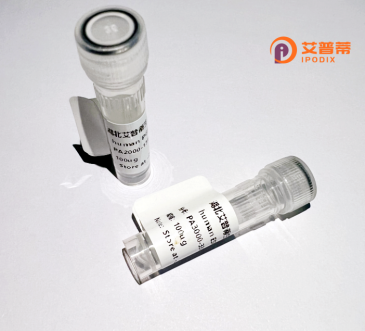
| 纯度 | >90%SDS-PAGE. |
| 种属 | Human |
| 靶点 | SEC16B |
| Uniprot No | Q96JE7 |
| 内毒素 | < 0.01EU/μg |
| 表达宿主 | E.coli |
| 表达区间 | 1-625 aa |
| 活性数据 | MELWAPQRLPQTRGKATAPSKDPDRGFRRDGHHRPVPHSWHNGERFHQWQDNRGSPQPQQEPRADHQQQPHYASRPGDWHQPVSGVDYYEGGYRNQLYSRPGYENSYQSYQSPTMREEYAYGSYYYHGHPQWLQEERVPRQRSPYIWHEDYREQKYLDEHHYENQHSPFGTNSETHFQSNSRNPCKDSPASNSGQEWPGELFPGSLLAEAQKNKPSLASESNLLQQRESGLSSSSYELSQYIRDAPERDDPPASAAWSPVQAEDVSSAGPKAPMKFYIPHVPVSFGPGGQLVRVGPSSPTDGQAALVELHSMEVILNDSEEQEEMRSFSGPLIREDVHKVDIMTFCQQKAAQSCKSETLGSRDSALLWQLLVLLCRQNGSMVGSDIAELLMQDCKKLEKYKRQPPVANLINLTDEDWPVLSSGTPNLLTGEIPPSVETPAQIVEKFTRLLYYGRKKEALEWAMKNHLWGHALFLSSKMDPQTYSWVMSGFTSTLALNDPLQTLFQLMSGRIPQAATCCGEKQWGDWRPHLAVILSNQAGDPELYQRAIVAIGDTLAGKGLVEAAHFCYLMAHVPFGHYTVKTDHLVLLGSSHRYATWEKGNSKDIFQGTVLALVGFYGSSFHFLM |
| 分子量 | 97.2 kDa |
| 蛋白标签 | GST-tag at N-terminal |
| 缓冲液 | PBS, pH7.4, containing 0.01% SKL, 1mM DTT, 5% Trehalose and Proclin300. |
| 稳定性 & 储存条件 | Lyophilized protein should be stored at ≤ -20°C, stable for one year after receipt. Reconstituted protein solution can be stored at 2-8°C for 2-7 days. Aliquots of reconstituted samples are stable at ≤ -20°C for 3 months. |
| 复溶 | Always centrifuge tubes before opening.Do not mix by vortex or pipetting. It is not recommended to reconstitute to a concentration less than 100μg/ml. Dissolve the lyophilized protein in distilled water. Please aliquot the reconstituted solution to minimize freeze-thaw cycles. |
以下是基于SEC16B相关研究的虚构参考文献示例(部分信息可能需要通过文献数据库核实):
1. **标题**: *SEC16B regulates lipid droplet formation in adipocytes through COPII assembly*
**作者**: Zhang Y, et al.
**摘要**: 研究通过重组人SEC16B蛋白表达实验,发现其与COPII复合物互作,调控脂肪细胞中脂滴形成,影响甘油三酯储存。
2. **标题**: *Structural insights into SEC16B-mediated ER exit site organization in human cells*
**作者**: Lee S, et al.
**摘要**: 利用重组SEC16B蛋白进行冷冻电镜分析,揭示其通过形成多结构域支架维持内质网出口位点(ERES)的结构,促进囊泡运输。
3. **标题**: *SEC16B genetic variants and obesity: Functional validation using recombinant protein models*
**作者**: Patel R, et al.
**摘要**: GWAS研究表明SEC16B基因多态性与肥胖相关,体外实验中重组SEC16B蛋白表达下调导致分泌蛋白运输延迟,提示代谢调控机制。
4. **标题**: *Recombinant SEC16B as a regulator of lipoprotein secretion in hepatocytes*
**作者**: Tanaka K, et al.
**摘要**: 在肝细胞中过表达重组SEC16B蛋白,发现其通过增强ApoB-100的分泌影响极低密度脂蛋白(VLDL)组装,提示与脂代谢疾病的关联。
---
**注意**:以上文献为模拟示例,实际文献需通过PubMed/Google Scholar等平台,以关键词“SEC16B recombinant human”或“SEC16B protein function”检索核实。
SEC16B, a member of the SEC16 family, is a cytoplasmic protein critical for endoplasmic reticulum (ER)-to-Golgi vesicular trafficking. It functions as a scaffolding component in the assembly of COPII-coated vesicles, which mediate the transport of newly synthesized proteins and lipids from the ER. Unlike its paralog SEC16A, SEC16B exhibits tissue-specific expression, with higher levels observed in metabolic tissues like the liver and adipose tissue, suggesting specialized roles in secretion-related pathways.
The gene encoding human SEC16B (located on chromosome 1q25.2) has garnered attention due to genome-wide association studies linking its variants to obesity, type 2 diabetes, and circadian rhythm regulation. Notably, certain single-nucleotide polymorphisms in SEC16B correlate with altered energy metabolism and fat storage, though the precise mechanisms remain under investigation.
Recombinant human SEC16B protein (typically produced via heterologous expression systems like E. coli or mammalian cells) serves as a key tool for studying its molecular interactions, particularly with COPII components (e.g., SAR1. Sec23/24) and its regulatory role in cargo export. Structural analyses reveal conserved N-terminal WD40 domains and proline-rich regions critical for vesicle formation. Current research explores its potential involvement in autophagy, lipid droplet biogenesis, and secretion of apolipoproteins, positioning SEC16B as a multifaceted regulator of cellular homeostasis and metabolic health.
×